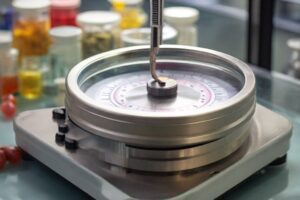The Art of Good Weighing Practices in Pharmaceuticals In the intricate world of pharmaceutical manufacturing, precision is paramount. Every pill, capsule, or solution is a meticulously crafted blend of ingredients, each requiring precise measurement to ensure efficacy, safety, and consistency. At the heart of this precision lies the humble weighing equipment – the unsung hero of pharmaceutical facilities. In this article, we delve into the art of good weighing practices, understanding the factors that affect measurements, and implementing procedures to enhance accuracy.
Calculating Measurement Error:
In the realm of pharmaceuticals, perfection is an illusion. Every measurement is subject to error, influenced by imperfections in instruments and methods. Understanding the components of measurement error – gross error, systematic error, and random error – is crucial. By recognizing these factors, operators can identify potential sources of discrepancy and take corrective measures to mitigate them.
Choosing the Right Weighing Balance:
Selecting the appropriate weighing balance is akin to choosing the right tool for the job. Whether it’s a four load-cell scale for heavy loads or a microbalance for laboratory precision, each balance serves a specific purpose. Ensuring that the correct balance is used at each stage of production is essential for maintaining accuracy and consistency.

Maintaining and Calibrating Weighing Instruments:
Routine maintenance and calibration are the backbone of reliable weighing practices. Regular testing and documentation of balances ensure data integrity, product safety, and quality. Adhering to manufacturer guidelines for calibration intervals and performing routine tests before measurement processes commence are critical to upholding accuracy.
Performing Quality Risk Management:
Quality risk management is the shield against inaccuracies in weighing. Operators can preemptively identify and address potential risks by comprehensively understanding the devices in use and assessing factors such as repeatability and sensitivity. This proactive approach minimizes the likelihood of errors and safeguards product quality.
Considering External Factors:
Weighing accuracy is not solely dependent on the equipment; external factors play a significant role. Oscillations, electrostatics, air currents, vibrations, magnetism, temperature fluctuations, and hygroscopicity are among the myriad factors that can influence measurements. Recognizing and mitigating these external influences is essential for achieving precise results.
Conclusion:
In the intricate dance of pharmaceutical manufacturing, precision is non-negotiable. Good weighing practices form the foundation upon which quality, safety, and consistency are built. By understanding the nuances of measurement error, selecting the right equipment, maintaining rigorous calibration standards, and preemptively managing risks, pharmaceutical companies can ensure that every dose meets the highest standards of accuracy and efficacy. Implementing these best practices enhances product quality and instills confidence in consumers, regulators, and stakeholders alike. In the world of pharmaceuticals, where every milligram matters, mastering the art of good weighing practices is the key to success.
Important aspects to consider when weighing API (Active Pharmaceutical Ingredient) samples in the analytical quality control lab of a pharmaceutical organization:
- Calibration and Maintenance:
- Regular calibration of weighing equipment to ensure accuracy.
- Maintenance of balances according to manufacturer guidelines to uphold performance.
- Environment Control:
- Control of environmental conditions such as temperature, humidity, and air currents to minimize interference with measurements.
- Use of dedicated weighing rooms or hoods to reduce external influences.
- Sample Preparation:
- Proper sample handling techniques to prevent contamination or loss of material.
- Ensuring samples are at room temperature to avoid temperature-related discrepancies.
- Selection of Weighing Equipment:
- Choosing the appropriate balance based on the quantity and sensitivity of the sample being weighed.
- Ensuring the balance has the necessary readability and precision for accurate measurements.
- Use of Analytical Balances:
- Use of analytical balances with high precision and readability for small sample quantities.
- Taring the balance with appropriate containers or weighing boats before adding the sample.
- Proper Technique:
- Gentle handling of samples to prevent spills or scatter, especially with powders or granules.
- Avoiding direct contact with samples to minimize contamination.
- Documentation and Record-Keeping:
- Accurate documentation of sample weights, including date, time, operator, and any relevant notes.
- Maintaining detailed records of calibration and maintenance activities for traceability and quality assurance purposes.
- Quality Control Checks:
- Performing periodic checks using certified weights to verify balance accuracy.
- Implementing routine quality control procedures to validate weighing processes.
- Safety Measures:
- Adherence to safety protocols, including wearing appropriate personal protective equipment (PPE) such as gloves and lab coats.
- Handling hazardous or toxic substances with caution and in accordance with safety guidelines.
- Data Integrity:
- Ensuring data integrity by following Good Documentation Practices (GDP) and Good Laboratory Practices (GLP).
- Implementing measures to prevent data manipulation or falsification.
- Training and Competency:
- Providing comprehensive training to lab personnel on proper weighing techniques and procedures.
- Regular competency assessments to ensure proficiency and compliance with standards.
- Risk Management:
- Identifying and assessing potential risks associated with weighing activities.
- Implementing risk mitigation strategies to minimize errors and ensure product quality and safety.
- Continuous Improvement:
- Encouraging feedback from personnel to identify areas for improvement in weighing processes.
- Implementing continuous improvement initiatives to enhance efficiency, accuracy, and compliance.
Frequently Asked Questions:
What are good weighing practices?
Answer: Good weighing practices involve meticulous attention to detail and adherence to standard procedures to ensure accurate and precise measurements. This includes proper calibration of equipment, careful handling of samples, maintaining suitable environmental conditions, and documenting all steps of the weighing process.
Why is proper weighing important in pharmaceutical practice?
Answer: Proper weighing is crucial in pharmaceutical practice to ensure the accurate dosage of active pharmaceutical ingredients (APIs) and other components in drug formulations. Precision in weighing directly impacts product efficacy, safety, and compliance with regulatory standards, thus safeguarding public health.
What is a weighing balance in the pharmaceutical industry?
Answer: In the pharmaceutical industry, a weighing balance is a precision instrument used to measure the mass of substances with high accuracy and reliability. These balances come in various types, such as analytical balances, precision balances, and microbalances, each suited for different weighing applications based on sensitivity and capacity.
What is the tolerance limit for weighing balance as per USP?
Answer: The tolerance limit for weighing balance, as specified by the United States Pharmacopeia (USP), depends on the class of the balance and is outlined in the relevant monograph. This limit defines the acceptable deviation from the true value in weighing measurements.
What is the basic principle of a weighing balance?
Answer: The basic principle of a weighing balance involves comparing the gravitational force acting on the object being weighed with a calibrated standard mass. This comparison is achieved through mechanical, electronic, or electromagnetic mechanisms to establish equilibrium and determine the object’s mass accurately.
What are the three methods of weighing?
Answer: The three methods of weighing include analytical weighing, precision weighing, and micro weighing. Each method is tailored to specific applications based on the required level of accuracy and the size of the sample being weighed.
What is weighing technique?
Answer: Weighing technique refers to the systematic approach employed to perform accurate and precise measurements using a weighing balance. This includes factors such as proper sample handling, calibration of equipment, minimizing environmental disturbances, and following standard protocols.
What is accuracy weighing?
Answer: Accuracy weighing refers to the ability of a weighing balance to provide measurement results that are close to the true value of the measured quantity. Achieving accuracy in weighing is essential for reliable and reproducible results in pharmaceutical applications.
How many types of balance are there in the pharmaceutical industry?
Answer: In the pharmaceutical industry, there are various types of balances used, including analytical balances, precision balances, and microbalances. Each type of balance is designed to meet specific weighing requirements based on factors such as sensitivity and capacity.
What is the purpose of weighing?
Answer: The purpose of weighing in pharmaceutical practice is to ensure precise measurement of ingredients, facilitating the formulation of pharmaceutical products with consistent potency, dosage uniformity, and adherence to regulatory standards.
Why is weighing good?
Answer: Weighing is considered good when conducted with meticulous attention to detail and adherence to standard procedures. Good weighing practices ensure accuracy, precision, and reliability in measurement, thus contributing to product quality, safety, and compliance.
What is weighing calibration?
Answer: Weighing calibration involves the process of adjusting and verifying the accuracy of weighing balances through comparison with reference standards. Calibration ensures that weighing equipment operates within acceptable limits and provides reliable measurement results.
What are the parameters of weighing balance?
Answer: Parameters of a weighing balance include sensitivity, readability, capacity, repeatability, linearity, and stability. These parameters collectively determine the instrument’s performance in terms of accuracy, precision, and reliability.
What is the difference between balance and weighing?
Answer: A balance is a precision instrument used for measuring mass, whereas weighing refers to the process of determining the mass of an object using a balance.
What is the difference between direct and indirect weighing?
Answer: Direct weighing involves placing the sample directly on the weighing pan, while indirect weighing entails determining the sample’s mass indirectly by comparison with a known standard or through displacement.
What are the steps in measuring weight?
Answer: The steps in measuring weight typically include taring the balance, placing the sample on the weighing pan, recording the measurement, and ensuring proper cleanup and maintenance of the equipment.
What is weighing by difference?
Answer: Weighing by difference is a technique used to determine the mass of a substance indirectly by measuring the difference in mass before and after adding or removing a known quantity of material. This method is commonly employed for substances prone to moisture absorption or volatile components.



